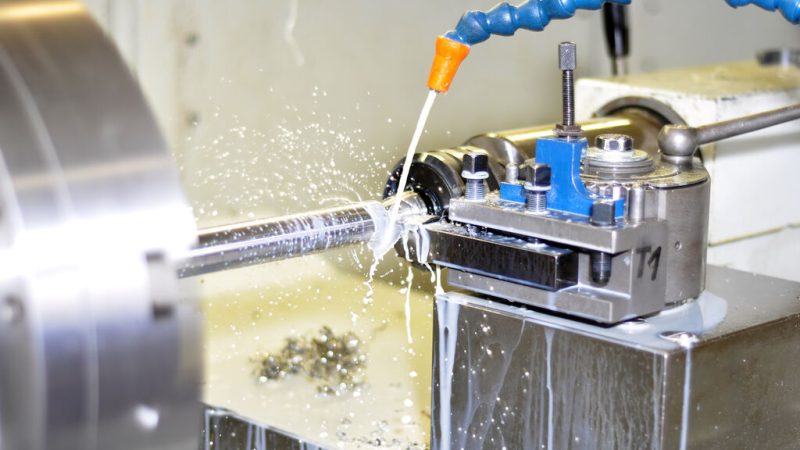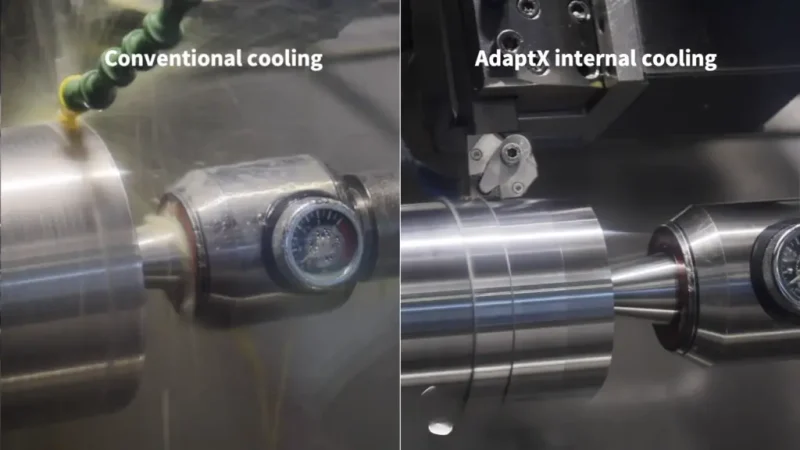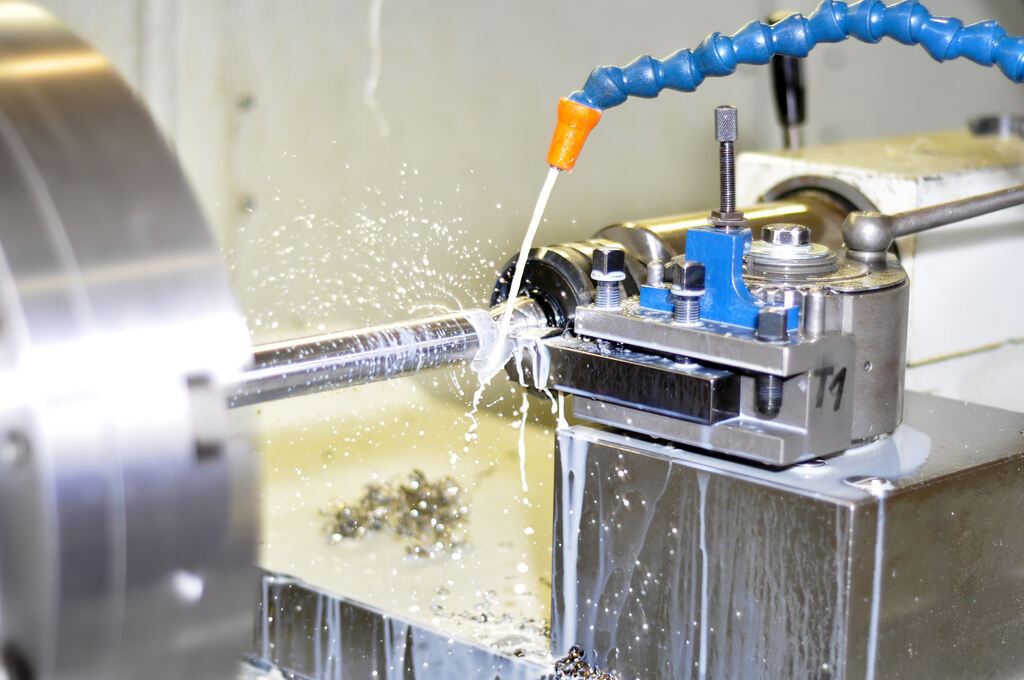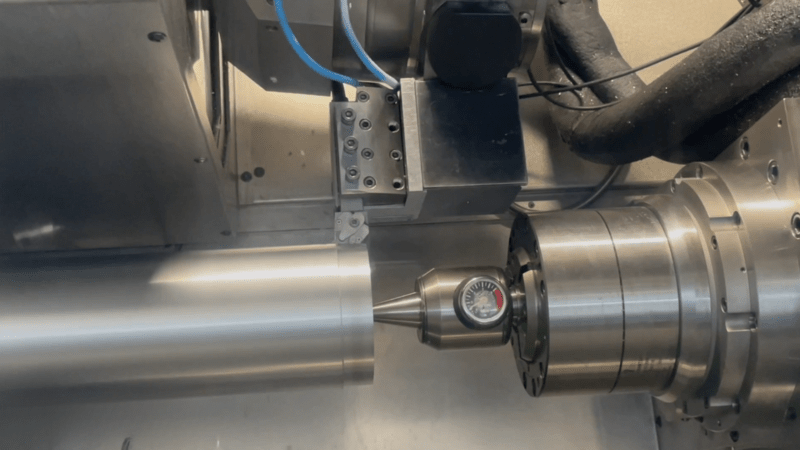Metal cutting is a crucial process in manufacturing, shaping the components used in countless products. While conventional cooling technologies for metal-cutting have served industries for decades, advanced solutions like AdaptX’s closed internal cooling are revolutionizing the field. Understanding the differences between these methods is key to optimizing efficiency, cost, and quality in production.
Understanding Conventional Machining
Conventional metal cutting refers to traditional methods such as turning, milling, and drilling, where material is removed from a workpiece using a cutting tool. These methods have been the backbone of the manufacturing industry for decades. Cutting fluids plays a vital role in these processes by cooling the tool and workpiece, reducing friction, and flushing away chips.
However, the reliance on external cutting fluids has its drawbacks. While they help reduce heat, they can be wasteful, pose environmental challenges, and even affect workers’ health due to chemical exposure. Moreover, the cooling isn’t always evenly distributed, leading to variations in tool wear and surface finish.

Challenges in Conventional Metal Cutting
One of the main issues in conventional metal cutting is heat generation. As the tool cuts through metal, immense friction is created, leading to high temperatures at the cutting zone. This heat can damage the cutting tool, reducing its lifespan and affecting the machined surface’s quality. The uneven cooling can result in thermal distortions, compromising the accuracy and finish of the product.
Additionally, the use of cutting fluids brings up environmental concerns. Disposing of hazardous waste is costly and requires strict safety measures. Despite these issues, conventional methods are still common because they are familiar and have established systems in place.
Introduction to AdaptX Closed Internal Cooling
That’s where AdaptX Closed Internal Cooling comes in – a modern solution designed to address many of the shortcomings of conventional cooling strategies for machining. Unlike traditional methods that rely on an open cooling system, AdaptX technology provides a self-sufficient and closed cooling system that doesn’t require any changes due to the closed design tool. This innovation ensures a dry machining process while the cutting zone is cooled precisely, resulting in more efficient heat dissipation.
AdaptX Closed Internal Cooling represents a significant shift from the status quo. It’s not just about where the coolant is applied, but how it’s managed throughout the machining process. The cooling elements allow efficient heat dissipation while using standard tools and tools holders allow easy integration.
How AdaptX Closed Internal Cooling Works?
The mechanism behind the AdaptX closed Internal Cooling system involves its integration with other machining tools used in metal cutting. AdaptX provides these tools with an efficient cooling solution by utilizing strategically placed internal channels, eliminating the need for traditional cutting fluids.
This internal cooling system reduces the overall heat generated during cutting, leading to longer tool life and better surface finishes. Technology is especially beneficial in high-speed machining, where traditional cooling methods might struggle to keep up with rapid heat buildup. It can be used in various machining processes, such as hard machining, steel machining, and plastic machining.
Comparing Conventional Cooling with AdaptX Closed Internal Cooling
| Category | Conventional Cooling | AdaptX Cooling |
| Cost Efficiency | Regular inspection, frequent replacement of filter systems, and extensive coolant use in traditional methods can lead to increased long-term costs due to the open system. | AdaptX Closed Internal Cooling can result in up to a 38% reduction in costs by minimizing the need for coolant recycling and lowering energy consumption. |
| Surface Finish | Offers broad cooling but may not always reach the cutting edge as effectively, potentially leading to less optimal surface finishes and reduced tool life under certain conditions. | Provides targeted cooling and adjustable temperature range, which can help improve surface finish and extend tool life, particularly in challenging cutting conditions. |
| Environmental Impact | Uses large amounts of coolant, leading to significant waste. High energy consumption due to large pumps and cooling units | Reduces environmental footprint by using coolant more efficiently and minimizing waste. |

Advantages of AdaptX Internal Cooling
- Enhanced Cooling Efficiency: Precise temperature control and lower temperatures down to -20°C allowing effective cooling.
- Extended Tool Life: Tools last longer due to better temperature management.
- Improved Surface Finish: Results in higher-quality finished products.
- Reduced Environmental Impact: Less coolant usage leads to less waste and lower disposal costs.
Disadvantages and Limitations
Despite its many advantages, AdaptX Internal Cooling does have some limitations:
1. Not Ideal for Every Machining/Material – While AdaptX closed internal cooling is highly effective for certain materials, it may not be suitable for all types of machining or materials.
2. Initial Focus on Turning Processes – The initial development of AdaptX closed internal cooling system was primarily focused on turning processes. The extension for milling and drilling is already being worked on.
Future Trends in Machining Technology
As industries continue to push for greater efficiency and sustainability, AdaptX Internal Cooling is likely to play a key role in the future of metal cutting. The trend is moving towards more integrated and intelligent systems, where machines are cooled internally and equipped with sensors to monitor performance in real-time. This will enable further optimization of the cutting process, leading to even greater improvements in efficiency and cost-effectiveness.
Conclusion
The comparison between conventional metal cutting and AdaptX Internal Cooling reveals a clear shift in the industry towards more sustainable, efficient, and cost-effective methods. While traditional methods are still widely used, the benefits of AdaptX technology—such as extended tool life, improved surface finish, and reduced environmental impact— leading to cost savings and making it an attractive option for forward-thinking manufacturers. As technology continues to evolve, AdaptX Internal Cooling is set to become a cornerstone in the next generation of machining innovations.






fw6g2u
obviously like your web site but you need to check the spelling on several of your posts. Several of them are rife with spelling problems and I find it very troublesome to tell the truth nevertheless I’ll definitely come back again.
В современную цифровую эру все больше владельцев техники сталкиваются с затруднительным выбором: что делать со старым домашним кинотеатром при покупке современного телевизора? Многие думают, что придется покупать новую акустическую систему. Однако существует несколько работающих способов совмещения прежней, но качественной техники с новыми устройствами. Такое решение не только поможет сэкономить значительную сумму, но и позволит продолжить использование проверенным временем оборудованием. Для тех, кому интересно, то по адресу можно узнать о том [url=https://1wyws.top/ ]как вывести звук телевизора на домашний кинотеатр через тюльпаны [/url] и много других познавательных публикаций в блоге 1wyws.top.
В статье подробно разбираются различные варианты соединения старых домашних кинотеатров к современным телевизорам – от использования HDMI-интерфейса с поддержкой технологии ARC до соединения через оптический выход или традиционные аналоговые разъемы. Каждый метод дополняется детальными руководствами и практическими рекомендациями. Особое внимание уделяется совместимости различных типов соединений и возможным техническим ограничениям. Пользователи найдут полезную таблицу совместимости разъемов, которая поможет быстро определить оптимальный способ подключения.
Материал также включает подробное описание типичных проблем, возникающих при подключении устройств разных поколений, и эффективные способы их решения. Авторы предлагают практическими советами по настройке звука и оптимизации работы системы. Пошаговые инструкции позволят даже неопытным пользователям успешно произвести подключение самостоятельно. Особенно ценным является раздел с описанием возможных сложностей и методов их устранения, что поможет не допустить многих распространенных ошибок при настройке оборудования.
Источник: [url=https://1wyws.top/tehnologii/330-kak-podklyuchit-staryj-domashnij-kinoteatr-k-novomu-televizoru/ ]https://1wyws.top/tehnologii/330-kak-podklyuchit-staryj-domashnij-kinoteatr-k-novomu-televizoru/ [/url]
Не стесняйтесь обратиться ко мне за помощью по вопросам как переделать колонки от домашнего кинотеатра – стучите в Telegram zye92
Покраска бампера автомобиля требует тщательной подготовительной работы и правильного подбора материалов. В первую очередь необходимо определить, сколько краски нужно на бампер, учитывая его размеры и качество поверхности. [url=https://emmanuelbibletraining.info/ ]Краска для бампера подбор на emmanuelbibletraining.info [/url] считается лучшим выбором для достижения отличного результата. Важно помнить, что перед применением нового покрытия следует тщательно подготовить поверхность, удалив старую краску и обезжирив пластик. Текстурная краска гарантирует не только эстетичный внешний вид, но и дополнительную защиту от механических повреждений.
Для тех, кто встретился с необходимостью удаления следов краски после ДТП, существуют различные методы решения проблемы. Чтобы оттереть краску с бампера от другой машины, специалисты рекомендуют использовать профессиональные смывки для краски с пластика бампера, которые эффективно справляются с задачей без повреждения основного покрытия. При работе с черной структурной краской важно учитывать время высыхания каждого слоя и соблюдать технологию нанесения, что позволит добиться однородного покрытия и долговечного результата.
Источник: [url=https://emmanuelbibletraining.info/ ]https://emmanuelbibletraining.info/ [/url]
по вопросам Стереть краску с бампера – стучите в Телеграм wpf95
Современные технологии GPON предоставляют передовые возможности для скоростного интернет-соединения, и многие пользователи задаются вопросом о правильном подключении роутера к такой сети. На сайте [url=https://netgate-kiev.blogspot.com/ ]Как подключиться к gpon роутеру на netgate-kiev.blogspot.com [/url] представлена подробная информация о различных способах настройки оборудования. Независимо от того, эксплуатируете ли вы оборудование от провайдеров МГТС или Ростелеком, важно понимать основные принципы подключения вашего роутера к GPON-терминалу для гарантии стабильного и быстрого интернет-соединения.
Процесс подключения роутера к GPON может различаться в зависимости от конкретного поставщика услуг и используемого оборудования. При подключении личного роутера к GPON-терминалу требуется учитывать особенности настройки VLAN, MAC-адресов и других настроек сети. Повышенное внимание следует уделить настройке Wi-Fi параметров и настройке безопасности сети, чтобы создать надежную защиту домашней сети. Многие клиенты успешно настраивают как стандартные роутеры провайдера, так и свои собственные устройства, главное – следовать инструкциям и корректно настраивать все параметры подключения.
Источник: [url=https://netgate-kiev.blogspot.com/ ]https://netgate-kiev.blogspot.com/ [/url]
по вопросам Как подключить роутер gpon – обращайтесь в Telegram yhh76
1eu5rg
u0l0hn